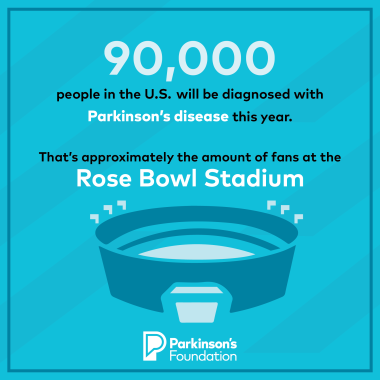Prevalence & Incidence
💡 Quick Summary
-
Nearly 90,000 people in the U.S. are diagnosed with Parkinson’s disease each year, representing a 50% increase from previous estimates.
-
Incidence rises with age, is higher in men, and varies by geographic region, reflecting an aging population.
-
By 2030, an estimated 1.2 million people in the U.S. will be living with Parkinson’s.
-
Prevalence increases with age, is higher in men, and differs across regions, highlighting the need for updated, representative data.
-
Accurate incidence and prevalence statistics help guide healthcare planning, research funding, advocacy and resource allocation to better support people with Parkinson’s and their families.

people in the U.S. are diagnosed with Parkinson's every year.
people with PD in the U.S. by 2030.
When a large population of people have a disease like Parkinson’s disease (PD), it’s essential to have accurate numbers of how many people have the disease, where they live and why they have it. This information helps researchers, healthcare professionals and even legislators determine how many resources should be allocated to addressing, treating and researching a disease.
Key terms, like incidence and prevalence, are often used when talking about Parkinson's statistics.
- Incidence: A measure of new cases arising in a population over a period of time. Typically incidence is measured as the number of people diagnosed per year.
- Prevalence: A measurement of all individuals affected by the disease at a particular time.
Parkinson’s Incidence

A 2022 Parkinson’s Foundation-led study reveals that nearly 90,000 people are diagnosed with Parkinson's disease every year in the U.S. This represents a steep 50% increase from the previously estimated rate of 60,000 diagnoses annually.
The study, titled "Incidence of Parkinson Disease in North America ," found that:
- PD incidence estimates increase with age in the 65+ range.
- The primary risk factor for PD is age.
- PD incidence estimates are higher in males as compared to females at all ages.
- The increase in the incidence of PD aligns with the growth of an aging population.
- PD incidence rates are higher in certain geographic regions: the “Rust Belt” (parts of the northeastern and midwestern U.S. previously regulated by industrial manufacturing), Southern California, Southeastern Texas, Central Pennsylvania and Florida.
This study is the most comprehensive assessment of PD incidence in North America based on five epidemiological (the study of a disease and its impact) sets of data to count the number of diagnoses in 2012. Prior PD incidence rates, based on smaller studies, were estimated to be in the 40,000 – 60,000 range per year. The new incidence rate is 1.5 times higher at nearly 90,000 cases annually.
“These updated estimates of incidence are necessary for understanding disease risk, planning health care delivery, and addressing care disparities. Knowing this information will allow us to better serve people with Parkinson’s and their families and plan for adequate health care services in the future."
- James Beck, PhD, Parkinson’s Foundation Chief Scientific Officer
This new study shows that Parkinson’s numbers are on the rise. “The growth in those diagnosed and living with PD underscores the need for policy makers to confront an increasing strain on clinical services as well as the need to provide additional funding for research that can lead to improved therapies if not an outright cure,” according to the study.
The study was supported by the Parkinson’s Foundation, The Michael J. Fox Foundation for Parkinson’s Research (MJFF) and the Institute for Clinical Evaluative Sciences (ICES).
Read the study in the Parkinson’s Foundation scientific journal, npj Parkinson’s Disease.
Parkinson’s Prevalence
According to the Parkinson's Foundation Parkinson's Prevalence Project, 1.2 million people in the U.S. will be living with Parkinson's by 2030.
This 2018 study sought to calculate an accurate estimate of the prevalence of Parkinson’s in North America. This study draws from a large group of populations with a diverse range of backgrounds. Read the study in the Parkinson’s Foundation scientific journal, npj Parkinson’s Disease.
Prior estimates were based on a small number of cases from areas that are not representative of the nation as a whole — the previous prevalence study, conducted 40 years ago, extrapolated the 26 people with PD in a rural Mississippi county as a benchmark estimate for PD prevalence in the U.S.
In addition to finding the most comprehensive number to date, the prevalence study sought to answer two main questions:
- Is the prevalence of PD uniform throughout North America or does it vary by study and/or geography?
- What will the data tell us about the prevalence of Parkinson’s and about the disease itself?
Parkinson’s Prevalence Facts
- The study confirms that men are more likely to have PD than women and that the number of those diagnosed with PD increases with age, regardless of sex.
- The study found that the prevalence of people diagnosed with PD varies by region. Study researchers will devote more time to finding out how.
- Prior to this 2018 study, the last major PD prevalence study was completed in 1978.
View the Parkinson's prevalence map
Why do Parkinson’s Prevalence and Incidence numbers matter?
Parkinson’s prevalence and incidence numbers help the Parkinson’s Foundation better support the PD community. Being equipped with these key estimates help the Foundation garner the attention of federal and state government as well as the pharmaceutical industry to effectively advocate for additional money and resources necessary to support PD research that ultimately leads to a cure.
Current Research
Learn more about Parkinson's research going on right now.
Parkinson’s Foundation prevalence and incidence numbers highlight the growing importance of optimizing Parkinson’s care and treatment for people with the disease, which would help future care partners and ease the strain on health and older adult care systems.
Through these studies, the Foundation works to better understand Parkinson’s with the goal of solving this disease. Establishing these numbers and using them to educate PD communities and influence legislation help the Foundation provide tailored resources, outreach and advocacy to priority populations across the nation.
Read the full study in the Parkinson’s Foundation scientific journal, npj Parkinson’s Disease.
Join the Fight Against Parkinson's
Support ground-breaking research, care and community outreach